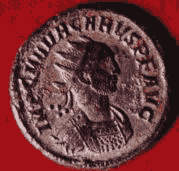 |
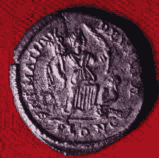 |
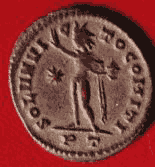 |
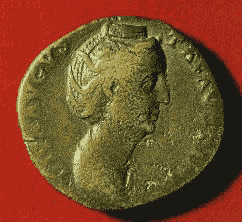 |
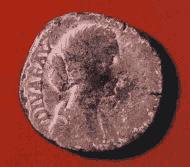 |
EC.72.11 Denomination: sestertius Date: c. 176-180 CE Obverse: Annia Galeria Faustina the Younger facing right, hair tied in bun
Inscription: DIVA FAV |
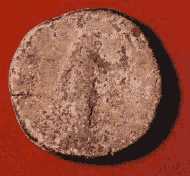 |
Reverse: Standing woman; no inscription Notes: This coin was likely issued after the death of Faustina the Younger (born c. 125 CE) The daughter of the emperor Antoninus Pius (ruled 138-160 CE) and Annia Galeria Faustina the Elder, Faustina the Younger married her cousin, the future emperor Marcus Aurelius (ruled 161-180 CE), in 145 CE. As shown by the inscription "DIVA" on this coin, Faustina the Younger was awarded divine honors. See also EC.72.85, EC.72.86, EC.72.87, and EC.72.88. Weight: 18 g
|
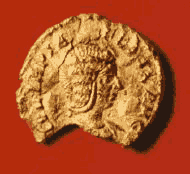 |
EC.72.12 Denomination: denarius Date: early 3rd century CE Obverse: Julia Domna facing right
Inscription: ...PIA IULIA AUG
|
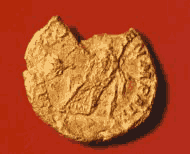 |
Reverse: Seated woman, faint Inscription: ...EN MPAT Notes: Julia Domna, a Syrian, was the second wife of emperor Septimius Severus (reigned 193-211 CE), and the mother of joint emperors Caracalla and Geta. She was a powerful political figure, in charge of Caracalla's civilian administration while he was on campaign. Julia Domna was also a member and patron of Rome's intelligentsia. After Caracalla's assasination in 217 CE, Julia Domna starved herself to death, either out of grief or on the command of the new emperor, Macrinus. Weight: 2 g
|
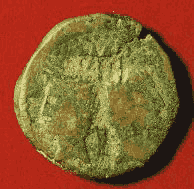 |
EC.72.13 Denomination: as Date: after 28 BCE Obverse: Heads of Augustus and Marcus Agrippa facing out
Inscription: IMP DIV |
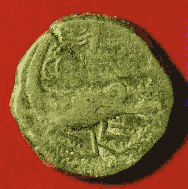 |
Reverse: Crocodile chained to a palm tree
Inscription: COL NIM Notes: This coin is from the Colony of Nemausus, present day N�mes, France. The city symbol of a crocodile chained to a palm tree was adopted when Augustus settled veterans of his Egyptian campaign there. Augustus's son-in-law Marcus Agrippa was responsible for much of the prosperity of N�mes, once one of the richest cities in the empire. Several well-known Roman monuments survive there, including the Maison Carr�e (c. 20 BCE) and the Pont du Gard aqueduct (late 1st century BCE). See EC.72.15. Weight: 11 g
|
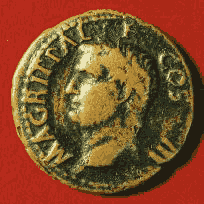 |
EC.72.15 Denomination: as Date: after 37 BCE Obverse: Uncrowned, beardless head of Marcus Agrippa facing left
Inscription: M AGRIPPA L F COS III |
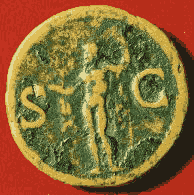 |
Reverse: Figure of a man standing
Inscription: SC Notes: Marcus Agrippa (c. 63-12 BCE) was one of the greatest supporters of Octavian (who later became the emperor Augustus). Agrippa was responsible for crucial military victories during Augustus's reign and for founding of several colonies (see EC.72.13). He additionally supervised and funded many civic improvement projects, including baths, aqueducts, and the first Pantheon of Rome (later rebuilt by Hadrian). Had he not died before Augustus, he may have been Augustus's successor. Weight: 9 g
|
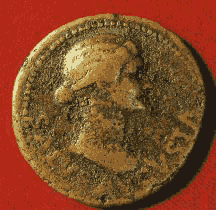 |
EC.72.16 Denomination: as Date: c. 14-37 CE Obverse: Head of Livia facing right, hair low
Inscription: SALUS AUGUSTA
|
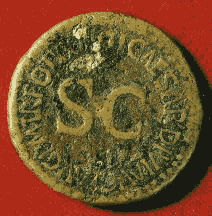 |
Reverse: no figure
Inscription: TI CAESAR DIVI AUG F AUG P M TR POT XXIIII. SC Notes: This coin was issued by Tiberius in honor of his mother Livia Drusilla (58 BCE - 29 CE). After the death of her husband, Emperor Augustus, in 14 CE, Livia took the name "Julia Augusta" in his honor (hence the name "Augusta" on this coin). Tiberius' decision to place Livia's likeness on a coin in lieu of his own attests to her popularity with the Romans. See EC.72.9, EC.72.17 through EC.72.20, and EC.72.21 for more coins and information on Tiberius. Weight: 13 g
|
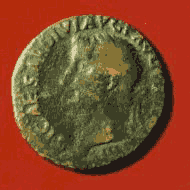 |
EC.72.17 Denomination: as Date: c. 14-37 CE Obverse: Uncrowned, beardless head of Tiberius facing left
Inscription: TI CAESAR DIVI AUG F...
|
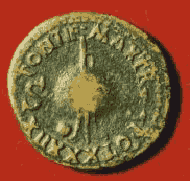 |
Reverse: No figure
Inscription: PONTIF MAX TR POT XXXIIX. SC Notes: See EC.72.9, EC.72.16, EC.72.18 through EC.72.20, and EC.72.21 for more coins and information on Tiberius. Weight: 9 g
|
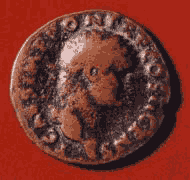 |
EC.72.18 Denomination: as Date: c. 14-37 CE Obverse: Uncrowned, beardless head of Tiberius facing right
Inscription: T CAES IMP PON TR P COS II CENS |
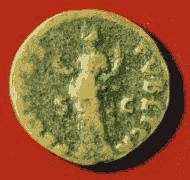 |
Reverse: Felicitas holding a cornucopia
Inscription: FELICITAS PUBLICA. SC See EC.72.9, EC.72.16, EC.72.17, EC.72.19, EC.72.20, and EC.72.21 for more coins and information on Tiberius. Weight: 8 g
|
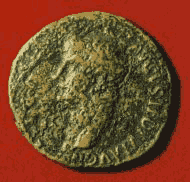 |
EC.72.19 Denomination: as Date: c. 14-37 CE Obverse: Uncrowned, beardless head of Germanicus facing left
Inscription: AUGUST F DIVI AUG N
|
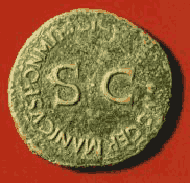 |
Reverse: No figure
Inscription: AUG GERMANICUS PON M TR POT. SC Notes: Germanicus was the brother of Claudius, and the nephew and adopted son of Tiberius. All Germanicus coins were issued under Tiberius. See EC.72.9, EC.72.16 through EC.72.18, EC.72.20, and EC.72.21 for more coins and information on Tiberius. Weight: 9 g
|
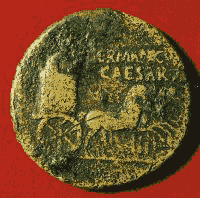 |
EC.72.20 Denomination: dupondius? Date: c. 17 CE Obverse: Germanicus riding to the right in a triumphal chariot drawn by four horses Inscription: GERMANICUS CAESAR Notes: This coin likely commemorates the triumph granted to Germanicus Caesar (15 BCE - 19 CE) in May of 17 CE. Germanicus was a very popular and successful general and defeated several German tribes between 14-16 CE. A triumph was the highest honor a general could receive, and allowed him to enter the city of Rome leading his troops in a ceremonial procession (if a general commanded his troops through Rome at any other time it was viewed as a coup against the emperor). The general would ride in a chariot strewn with laurels, wearing a purple and gold tunic and toga, while holding an ivory scepter in his left hand and a laurel branch in his right.
|
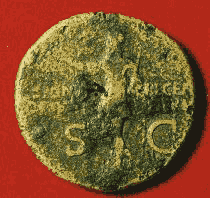 |
Reverse: Germanicus standing in full armor facing left with feet crossed and right hand raised
Inscription: SIGNIS RECEPT DEVICTIS GERM. SC Notes: Germanicus likely would have been Tiberius's successor had he not died prematurely. His supporters encouraged him to claim the empire as his own when Augustus died, but he remained loyal to Tiberius. He died around the age of 34, perhaps from poisoning in which Tiberius was implicated. See EC.72.9, EC.72.16 through EC.72.19, and EC.72.21 for more coins and information on Tiberius. Weight: 10 g
|